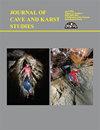新墨西哥州东北部早白垩纪克莱顿湖恐龙足迹遗址的摄影测量分析
IF 0.5
4区 地球科学
Q4 GEOSCIENCES, MULTIDISCIPLINARY
引用次数: 0
摘要
在2021年4月的NMGS春季会议上,我们的CNM/NMMNH团队做了一个关于使用无人机帮助收集古生物数据的报告。我们的具体项目是收集新墨西哥州克莱顿湖早白垩纪恐龙足迹遗址的数据。在2021年春季会议召开时,数据已经收集,但数据集的处理才刚刚开始。这些数据包括3632个文件,其中包含29.9 gb的陆地和无人机图像。使用领先的专业无人机测绘摄影测量软件Pix4D,以fbx格式创建三维计算机模型。处理过程耗时;例如,“地面”图像,通过相机拍摄来产生单个轨道和其他特征的三维模型,每个模型需要12-20小时的计算机处理。这一处理过程在32个文件中增加了1.9 gb的数据。截至2022年春季会议,所有数据都已处理完毕,我们可以呈现结果。摄影测量数据已被用于创建轨道站点的地图/正射影像,该地图/正射影像具有毫米等高线,可作为未来管理和监测由于侵蚀和风化导致的轨道站点变化的基线。精细的图像允许对轨道进行各种度量分析,以评估轨道的地语学历史和动态。大约有533条恐龙足迹被确认并记录在案。其中,182条可分为28条轨道。对于这些轨道,我们可以估计轨道制造者的臀部高度、速度和方位。摄影测量数据也揭示了克莱顿湖恐龙足迹的复杂性和缺陷,它们在不同粘度的基质上形成了多期足迹,因此足迹质量相对较低,并且存在广泛的外变质作用本文章由计算机程序翻译,如有差异,请以英文原文为准。
Photogrammetric Analysis of the Clayton Lake Dinosaur Tracksite, Early Cretaceous of Northeastern New Mexico
At the NMGS Spring Meeting in April of 2021, our CNM/NMMNH team made a presentation on the use of drones to aid in the collection of paleontological data. Our specific project was to collect data on the Early Cretaceous dinosaur tracksite at Clayton Lake, NM. At the time of the 2021 Spring Meeting, the data had been collected, but processing of the dataset had just begun. Those data consist of 3,632 files containing 29.9 gigabytes of terrestrial and drone imagery. Pix4D, the leading photogrammetry software for professional drone mapping, was used to create three-dimensional computer models in fbx format. Processing was time consuming; for example, “terrestrial” images, taken by camera to produce 3-D models of individual tracks and other features, took 12-20 hours of computer processing per model. The processing resulted in an additional 1.9 gigabytes of data in 32 files. As of the Spring Meeting in 2022, all of the data have been processed, and we can present the results. The photogrammetric data have been used to create a map/orthophoto of the tracksite with mm-scale contours that can serve as a baseline for future management and monitoring of tracksite changes due to erosion and weathering. The fine-scaled imagery allows a variety of metric analyses of the tracksite to be undertaken to evaluate the taphonomic history and dynamics of the tracks. Approximately 533 dinosaur tracks have been identified and documented. Of these, 182 can be grouped into 28 trackways. For these trackways we can estimate the hip height, speed, and bearing of the trackmaker. The photogrammetric data also reveal the complexity and defects of the Clayton Lake dinosaur tracks, which represent multiple episodes of footprint formation on substrates of diverse viscosity so that track quality is relatively low, and there is extensive extramorphological
求助全文
通过发布文献求助,成功后即可免费获取论文全文。
去求助
来源期刊

Journal of Cave and Karst Studies
地学-地球科学综合
CiteScore
1.90
自引率
0.00%
发文量
6
审稿时长
>12 weeks
期刊介绍:
The Journal of Cave and Karst Studies is a multidisciplinary journal devoted to cave and karst research. The Journal is seeking original, unpublished manuscripts concerning the scientific study of caves or other karst features. Authors do not need to be members of the National Speleological Society, but preference is given to manuscripts of importance to North American speleology.
 求助内容:
求助内容: 应助结果提醒方式:
应助结果提醒方式:


